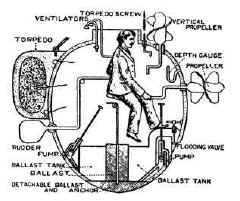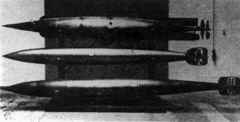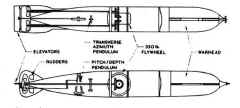History of the Torpedo - The Early Years.
Believe it or not, the word "torpedo" was
first used by David Bushnell, an American in the Eighteenth century. The
word "Torpedo" is from a family of fish - the Torpedinidae,
(Electric Ray), as the
Readers Digest Dictionary states "...having a rounded body and a
pair of electric organs capable of producing a fairly strong electric
charge." In fact - to it's prey - it's a stunning shock!
It is suggested that Bushnell first used the term
"Torpedo" to an invention of his - a mine attached to the hull
of a ship and detonated possibly by a clockwork fuse. (This was achieved
however by using a boat, designed by Bushnell, that was manually
pedal-powered and went under the water - the first submarine? see
picture on the right) All types
of water bound explosive devices, i.e., floating mines, floating barrels
of burning pitch (carried to the target by the water current), and spar
torpedoes (approximately 60lb charge was fixed on the end of a 25 foot
pole, was exploded below the waterline).
|

From Pointed-nosed to
Blunt-nosed Torpedoes.
|
As the torpedo weapon finally developed though the
years, there were a number of companies and countries making them.
Originally, the first torpedoes were built with pointed noses, to 'cut'
through the water easier, but Dr. Froude (a hydrodgnamicist and
working with Whitehead)
believed a blunt nose torpedo could carry a heavier warhead without loss
of speed. A test was set up using one of each model, and results were
the blunt nosed torpedo gained a full one knot advantage.
|
The German firm L. Schwartzkopf (later to be
known as Berliner Maschinenbau A.G.), were producing about 400
weapons annually, shipping them to Spain, Italy, China and Great
Britain. Then in 1904, the Battle of Tsushima was finally ended by
gunfire as there was no torpedo built (at the time) which could reach
ranges of 600 yards. The main benefit of the torpedo was the stealth and
shock - the Torpedinidae family!
"The Torpedo Test Station" was set
up at Rhode Island, (USA), in 1870, working on spar torpedoes, later,
improved mainly by Mr. J.L. Lay, an US Naval
Officer, produced the 18 inch Lay Weapon. Other types of torpedoes being built at this time
around the world include:
16 inch Ericsson
- 300lb warhead with a range of approximately 100 yards.
22 inch Patrick
- 200lb warhead with a range of approximately 2,000 yards
14 & 18 inch Fiume
(Whitehead) - 200/220lb warhead with a range of
approximately 400/1,000 yards.
29 inch Nordenfelt
- 300lb warhead with a range of 4,000 yards.
14 & 18 inch Howell
- 100/180lb warhead with a range of 400/1,200 yards.
21 inch Brennan
- 200lb warhead with a range of 3,000 yards.
BACK.
These listed above are only a VERY FEW of the
torpedoes being designed, and through the years - right up to modern day
weapons, one can see how they evolved. Some are still in use to-day like
the 21 inch Whitehead Torpedo which was used during the Falklands
conflict to devastating effect.
The Lay torpedo (pictured
right), was powered by
a gas engine driven by compressed carbon dioxide, and steered by impulses transmitted down a wire, operating electromagnetic relays on
the rudder. Unreliable majority of the time, two Lay torpedoes were sold
to the Peruvian Government in the war with Chile. A Lay' was fired from
the Huascar (Peruvian Ironclad ship) at a Chilean ship - half-way
there the Lay' turned about and came back to the mother ship at 15 knots
- despite frantic efforts of the operator. The ship was saved by an
officer swimming out to the torpedo and deflecting it! The captain took
the two weapons to the local graveyard to be buried, only for the
Chilean rebels to rescue them!
impulses transmitted down a wire, operating electromagnetic relays on
the rudder. Unreliable majority of the time, two Lay torpedoes were sold
to the Peruvian Government in the war with Chile. A Lay' was fired from
the Huascar (Peruvian Ironclad ship) at a Chilean ship - half-way
there the Lay' turned about and came back to the mother ship at 15 knots
- despite frantic efforts of the operator. The ship was saved by an
officer swimming out to the torpedo and deflecting it! The captain took
the two weapons to the local graveyard to be buried, only for the
Chilean rebels to rescue them!
BACK
The Ericsson torpedo was
the first to be powered by electric in 1873. Propulsion was by having
power down a cable, unreeled from the torpedo. The torpedo had a large
float and obtained a speed of 10 knots. The final model built in 1889
had a 400lb warhead and a range of over two miles!
Ericsson also produced a rocket-powered torpedo
(after the Whitehead model made it's appearance), with a speed of 40 to
60 knots and a range of 100 yards.
BACK
The Patrick torpedoes used
carbon dioxide gas expanded through a gas engine - usually a three
cylinder Brotherhood type (similar to the one used extensively by
Whitehead). It was suspended by two unsinkable floats. made from either
wood or thin copper sheet cylinders with water-proof gun cotton.
BACK
The Fiume Whitehead
torpedoes have had many, many designs. (See the picture below for a
selection.) In 1895, the first significant
improvements to the torpedo design came when Whitehead introduced the
gyroscope for azimuth control using the type invented by the Austrian
Ludwig Obry. This device consisted of a 1.75lb wheel about 3 inch in
diameter was held in gimbals with it's axis along that of the torpedo.
The wheel was spun to a maximum speed of 2,400 r.p.m. by using a
pretensioned spring, and was achieved before the torpedo was fired
through the tube. This meant that the torpedo went in the line it was
fired and any other pulses etc, hitting the water had no effect on the
torpedo. Theoretically, a torpedo like this one could, when on the
correct line of fire, hit a target at a range of 7,000 yards, except
that torpedoes of this time only managed 1,000 yards. was spun to a maximum speed of 2,400 r.p.m. by using a
pretensioned spring, and was achieved before the torpedo was fired
through the tube. This meant that the torpedo went in the line it was
fired and any other pulses etc, hitting the water had no effect on the
torpedo. Theoretically, a torpedo like this one could, when on the
correct line of fire, hit a target at a range of 7,000 yards, except
that torpedoes of this time only managed 1,000 yards.
The gyro's one main problem is that it would topple over after a
short run, due to the gyroscope gimbals were required to directly
operate a rudder servo control as well. Whitehead was, it appears well
ahead of the field in torpedo design, in fact he introduced a second
servo which greatly reduced the forces acting on the gimbals - the way
was opened up now for long range torpedoes.
BACK

The Nordenfelt torpedo
had a large number of batteries, the earlier models had 108 cells
producing it's power. The steering mechanism was by electrical impulses
transmitted down a cable wire from the torpedo , which totalled a mile
in length. This torpedo also had floats, two to stop it from sinking.
BACK
 The Howell torpedo built in
the USA, became the major torpedo for the American Navy for 20 years -
and so preferred than the Whitehead torpedo. (See picture left.) It was ship launched from a
tube, a flywheel was set spinning (12,000 r.p.m.) before firing,
transmitting power to turn propellers, giving a speed of 30 knots over
an 800 yard range. There were really three main advantages that the
Howell' had over the Whitehead', (see picture on right), apart The Howell torpedo built in
the USA, became the major torpedo for the American Navy for 20 years -
and so preferred than the Whitehead torpedo. (See picture left.) It was ship launched from a
tube, a flywheel was set spinning (12,000 r.p.m.) before firing,
transmitting power to turn propellers, giving a speed of 30 knots over
an 800 yard range. There were really three main advantages that the
Howell' had over the Whitehead', (see picture on right), apart  from the simplicity - it left no
track, (in the water), it did not vary it's trim and it kept a straight
course. This was achieved by using the gyroscopic actions of the
flywheel, as the flywheel axis was transverse, any deviations from a
straight line caused the torpedo to keel over. This movement was
detected by a transverse mounted pendulum which was directly connected
to rudders which in turn forced a correction in course - so producing a
righting torque. from the simplicity - it left no
track, (in the water), it did not vary it's trim and it kept a straight
course. This was achieved by using the gyroscopic actions of the
flywheel, as the flywheel axis was transverse, any deviations from a
straight line caused the torpedo to keel over. This movement was
detected by a transverse mounted pendulum which was directly connected
to rudders which in turn forced a correction in course - so producing a
righting torque.
Note: This was the first torpedo to use gyroscopes
and when Whitehead started to use them in 1895, Howell started a legal
battle over patient rights.
BACK
The Brennan torpedo was
designed by an Australian watchmaker and was powered by pulling two 18 gauge piano wires out of the weapon. (See picture on the
right.) A steam winch (shore mounted)
pulled the wires out of the drums inside the torpedo - the action drove
the contrating propellers. Steering was by varying the tensions on the
wire/s causing the torpedo to hell over - compensated by a pendulum in
the steering controls.
gauge piano wires out of the weapon. (See picture on the
right.) A steam winch (shore mounted)
pulled the wires out of the drums inside the torpedo - the action drove
the contrating propellers. Steering was by varying the tensions on the
wire/s causing the torpedo to hell over - compensated by a pendulum in
the steering controls.
This weapon was used for coastal defences by the
Royal Engineers over a 20 year period, from around 1900. Hugh
Brotherhood winches were installed in concrete blockhouses, with the
torpedoes been run on rails down to the water. (One of these
derelict station remains have been discovered on the Thames estuary.)
BACK
|